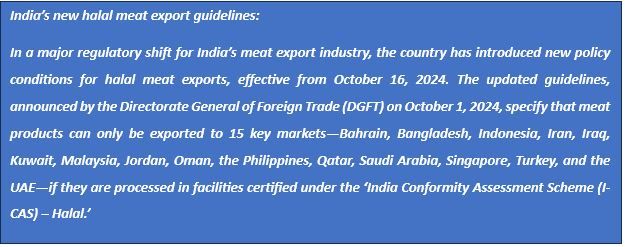Halal 물류 시장, 2032년까지 ~7.8% 성장하여 USD 십억 달러 규모 도달 전망, UnivDatos 발표
저자: Shalini Bharti, Research Analyst
2025년 3월 17일
보고서 주요 하이라이트:
- 정의 및 준수:Halal 물류는 인증된 수단을 통해 이슬람 율법(샤리아)에 따라 비할랄 제품과의 교차 접촉을 방지하기 위해 제품의 운송, 보관 및 유통 절차를 의미합니다.
- 증가하는 글로벌 수요:글로벌 무슬림 인구는 2030년까지 22억 명으로 증가할 것으로 예상되며, 이는 할랄 식품, 의약품 및 화장품의 소비를 촉진하여 할랄 물류 서비스가 필요하게 될 것입니다.
- 지역 시장 성장:동남아시아, 중동, 북미 및 유럽을 포함하는 개발 지역의 인구 증가는 이러한 서비스의 성장을 보완할 것입니다. 이러한 지역의 규제가 할랄 물류에 긍정적으로 작용했으며, 일반 인구는 건강하고 품질 좋은 소비재에 대해 더 많은 관심을 보이고 있기 때문입니다.
- 채택 전략:많은 기업들이 할랄 인증 창고, 전용 운송 시스템, 콜드체인 시스템, 블록체인 추적성을 출시하고 직원 교육 프로그램을 실시함에 따라 할랄 물류 시장의 중요성이 커지고 있습니다.
- 기술 및 전자 상거래 통합:블록체인, IoT 및 RFID의 적용은 할랄 제품의 추적성을 향상시키는 반면, 전자 상거래 확장은 전 세계적으로 보다 안전하고 투명한 할랄 공급망에 대한 수요를 증가시킵니다.
UnivDatos의 새로운 보고서에 따르면,Halal 물류 시장은 2032년까지 연평균 성장률(CAGR) 7.8%로 성장하여 USD 십억 달러 규모에 이를 것으로 예상됩니다. 할랄 물류 성장의 원동력은 2030년까지 22억 명으로 추정되는 글로벌 무슬림 인구로, 식품, 의약품, 화장품 등 할랄 제품에 대한 수요를 증가시키고 있습니다. 동남아시아 및 중동과 같은 지역에서 할랄 공급망 흐름을 위해 정부 정책 및 제도적 요구 사항을 강화하는 것은 기업 압력을 가속화하고 있습니다. 또한, 전자 시장의 성장은 진품 제품 및 배송에 대한 소비자 요구를 충족할 수 있는 추적 가능하고 신뢰할 수 있는 할랄 물류 솔루션에 대한 수요를 창출합니다..
예를 들어, 2021년 3월 5일, Nippon Express Co., Ltd. (사장 Saito Mitsuru)는 3월 8일부터 새로운 할랄 인증 국내 항공 화물 운송 서비스를 시작하여 일본에서 국내 할랄 물류 서비스를 확대했습니다. 일본의 무슬림 인구는 약 200,000명이며, 다양한 문화적 배경을 가진 외국인 방문객/거주자의 증가가 예상됨에 따라 일본에서 할랄 제품에 대한 수요가 증가할 것으로 예상됩니다. 또한, 품질 보증 및 위생 관리에 대한 높은 인증 기준은 건강과 안전을 중시하는 소비자들 사이에서 할랄 제품에 대한 관심을 확대시켰습니다.
업계를 변화시키는 세그먼트
- 서비스 유형을 기준으로 시장은 운송{도로, 철도, 항공, 해상}, 창고 보관 및 엔드 투 엔드 공급망 솔루션으로 세분화됩니다. 운송은 2023년에 시장에서 상당한 점유율을 차지했습니다. 특히 할랄 육류 및 식품과 같은 부패하기 쉬운 품목이 비할랄 품목과 접촉하지 않고 운송되도록 보장함으로써 할랄 물류 개발에 중요한 역할을 합니다. 이는 국제 무역에서 할랄 식품에 대한 수요가 증가하고 다양한 무슬림 지배 국가에서 인터넷 식품 판매 플랫폼이 발전하고 있기 때문입니다. 제조업체는 할랄 인증 전용 차량, 밀봉된 컨테이너, 그리고 제품 운송에 사용되는 차량을 추적하기 위한 GPS를 사용함으로써 대응합니다. 또한, 공급망의 다양한 당사자들이 처음부터 끝까지 할랄 요구 사항을 충족하기 위해 노력함에 따라 온도 조절 할랄 공급망 물류 구축에도 더 많은 투자가 이루어지고 있습니다..
보고서에 따르면, Halal 물류의 영향은 현재 규제로 확인되었습니다:

보고서 주요 제공 사항
수익 기준 시장 규모, 동향 및 예측 | 2024−2032.
시장 역학 – 주요 트렌드, 성장 동력, 제약 및 투자 기회
시장 세분화 – 서비스 유형별, 최종 사용자 산업별, 지역/국가별 상세 분석
경쟁 환경 – 주요 주요 공급업체 및 기타 주요 공급업체
콜백 받기
